Jobs Situation Report 8th Edition (7 October)
Over 33,000 jobseekers placed into opportunities under the SGUnited Jobs and Skills Package. Government will focus on matching more jobseekers into the opportunities.
- This edition of the Jobs Situation Report provides an overall update on the opportunities under the SGUnited Jobs and Skills Package since the announcement in Fortitude Budget in May to curate 100,000 jobs and skills opportunities to support local jobseekers. We will also highlight the challenges in achieving successful matches into these opportunities.
- By now, the National Jobs Council has curated more jobs and skills opportunities than the initial target. This is good progress, but we must press on. Majority of the opportunities remained unfilled. It takes time for jobseekers to overcome their reservations about switching to unfamiliar roles. Employers too are getting used to looking beyond candidates whose backgrounds are an exact match for the jobs.
- The Government will continue to curate more opportunities to help our jobseekers remain employable and be better-positioned for the eventual economic recovery. The $1 billion Jobs Growth Incentive (JGI) will also encourage growing firms to hire more locals. As we shift our focus towards supporting more successful matches, we will need both jobseekers and employers to keep an open mind.
Opportunities under SGUnited Jobs and Skills Package
- As at end-August, 117,500 committed opportunities under the SGUnited Jobs and Skills Package have been made available. The additional 25,500 opportunities are a nearly 30% increase from 92,000 as at end-July. Details are in Charts 1 and 2.
- The breakdown of opportunities between jobs (70%) and company-hosted opportunities and training places (30%) as at end-August is similar to that a month ago.
a. 17,000 of the new opportunities are jobs, bringing the number of such opportunities curated as at end-August to 82,700. Of these opportunities, the majority (73%) consists of long-term jobs, slightly higher than a month ago (68%).
b. 7,900 of the new opportunities are company-hosted attachment and training places, bringing the number of such opportunities curated as at end-August to 34,800. Of these opportunities, the majority (86%) are suitable for PMETs, about the same as the proportion as at end-July.
c. Government-funded opportunities or public sector jobs accounted for most of the growth. However, of the nearly 60,000 long-terms jobs available (Chart 2), the private sector still offered significantly more (37,290) compared to the public sector (22,700).
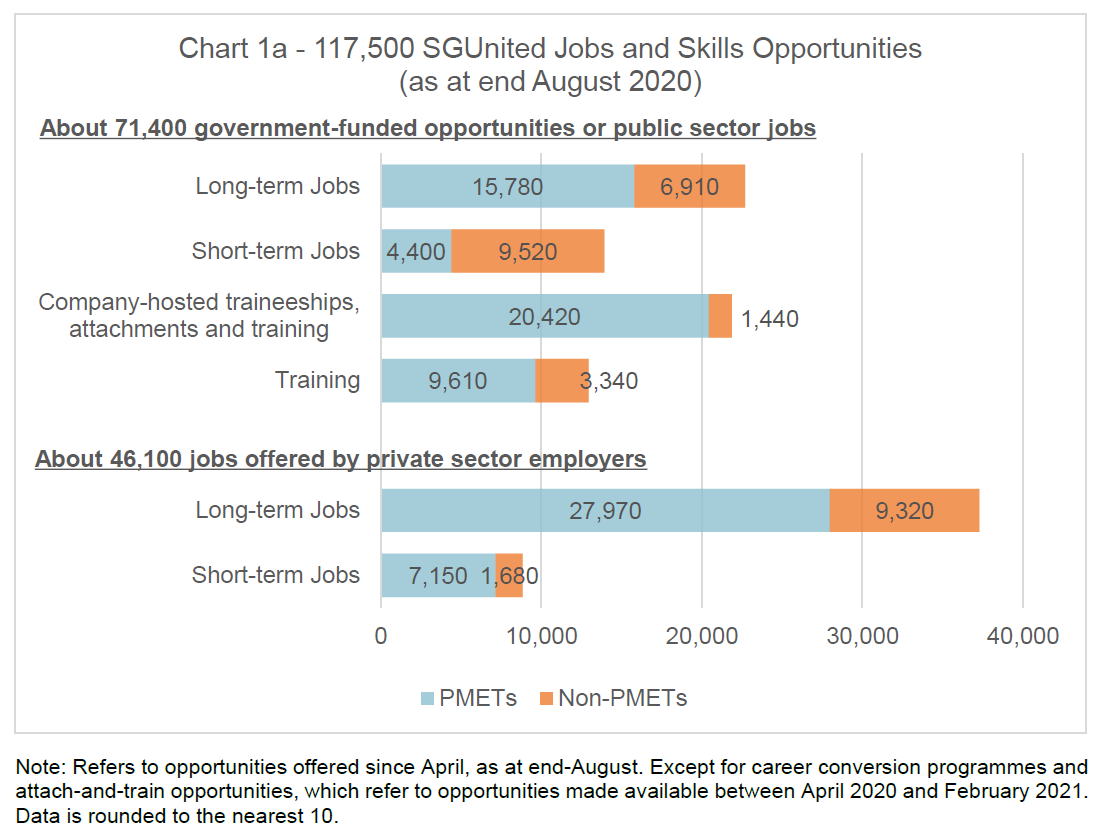
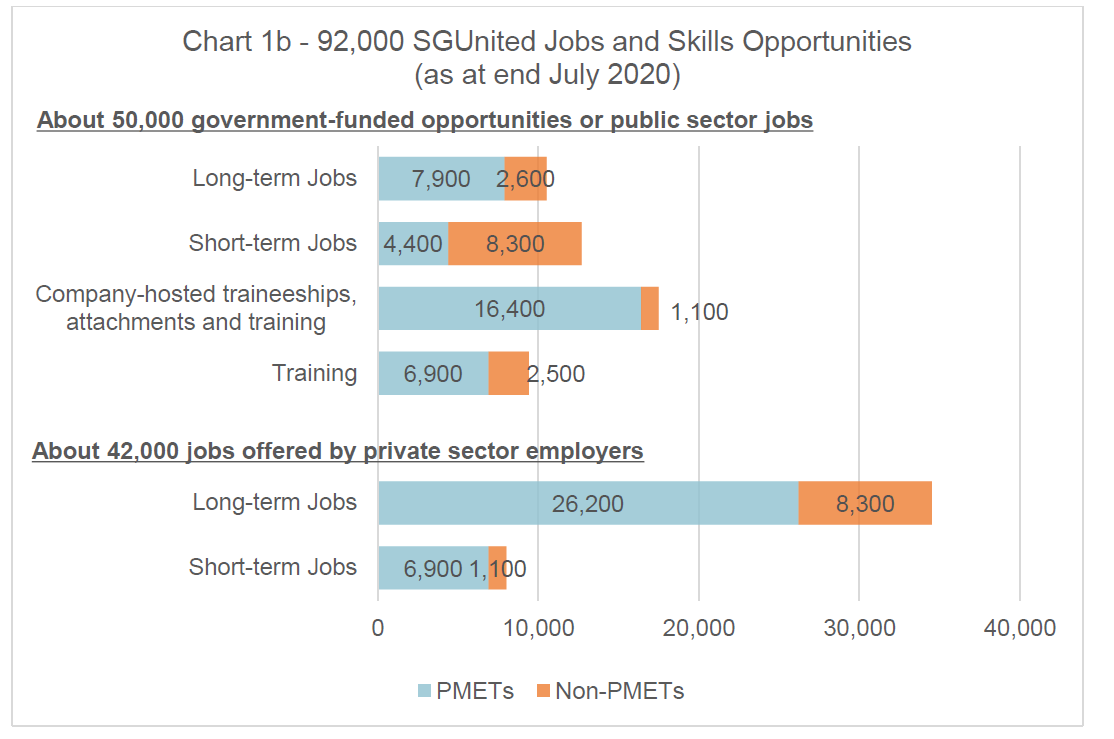
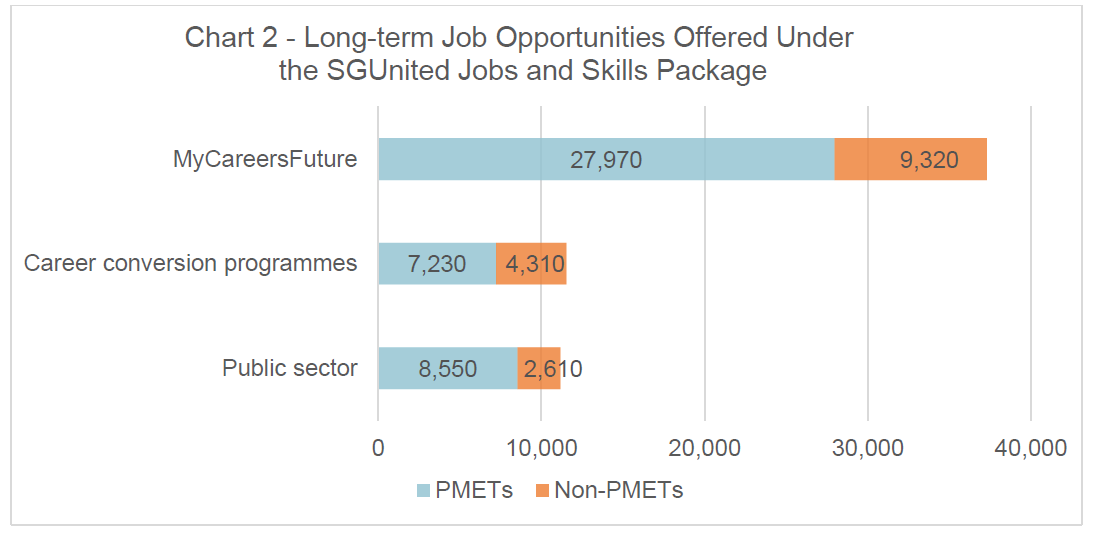
Top sectors offering opportunities
- Most of the opportunities continue to come from the growth sectors. The top five sectors remain unchanged, i.e. Information & Communications, Healthcare, Professional Services, Finance & Insurance and Manufacturing (breakdown by types of opportunities in Chart 3).
a. The Information & Communications sector offered the highest number of opportunities (19,860) – more than half of the opportunities are company-hosted opportunities and training places that allows jobseekers with little or no prior experience to gain exposure in order to take on future job roles within the sector. Company-hosted opportunities such as roles in application developer and graphics engineers and examples of training courses available in these sectors are listed in Annex B.
b. The Healthcare sector offered the highest number of long-term jobs (6,850), such as nursing professionals, allied health and related professionals, dental assistants and healthcare assistants/care workers.
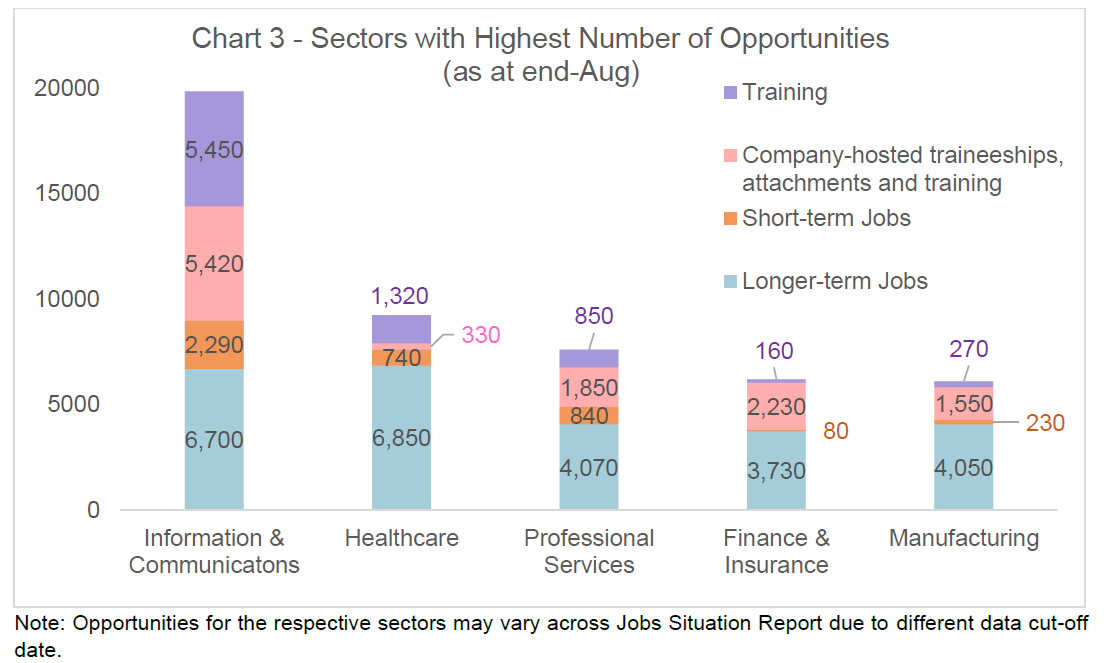
- Besides the growth sectors, the next few top sectors offering opportunities are the Education, Wholesale Trade and Food Services sectors (refer to Table 1 in Annex B), similar to the opportunities made available as at end-July.
Placements under SGUnited Jobs and Skills Package
- As at end-August, 33,100 jobseekers have been placed into these opportunities (breakdown in Chart 4), an increase of 9,100 from the 24,000 jobseekers placed as at end-July. This will continue to increase as many more jobseekers are matched through the selection process.
- Placements into jobs increased by 5,580, bringing the total to 29,580. Job placements of less than 12 months’ duration have fallen to 55% compared to 58% as at end-July. This was mainly due to the Government’s earlier focus in placing jobseekers and affected workers into short-term public sector jobs to handle the surge in COVID-19 related operations. Conversely, placements into long-term jobs have risen to 45% (13,370), up from 42% as at end-July (Chart 5).
a. For permanent positions, jobseekers are more likely to invest time in the search process of around three to six months or longer.
b. Employers also tend to take a longer time to fill permanent job positions, as they identify jobseekers with the best fit with the jobs and their organisations.
c. Matching of longer-term jobs therefore typically takes longer than shorter-term jobs.
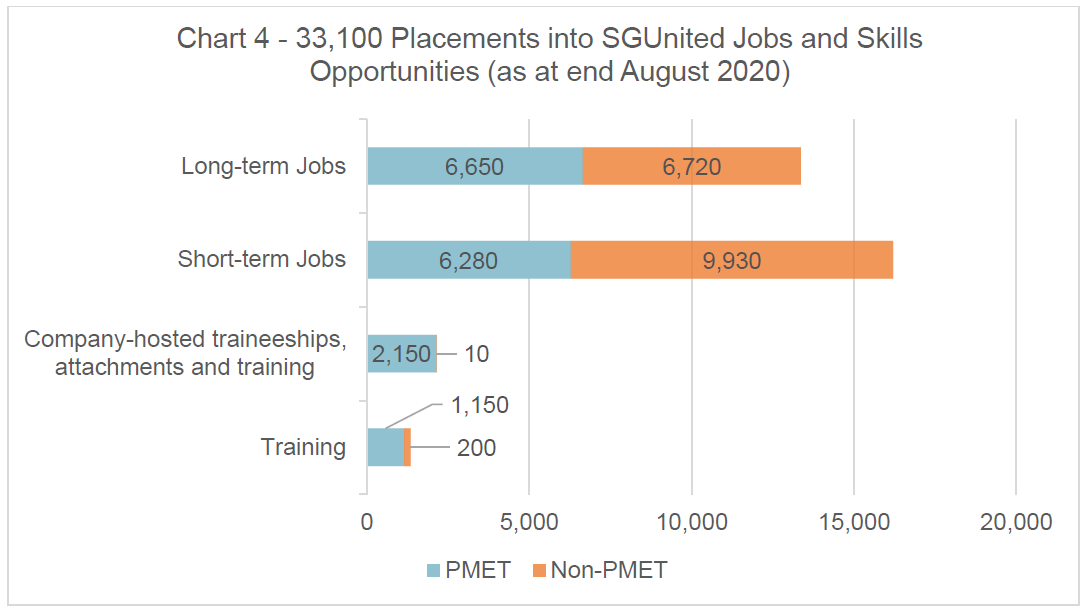
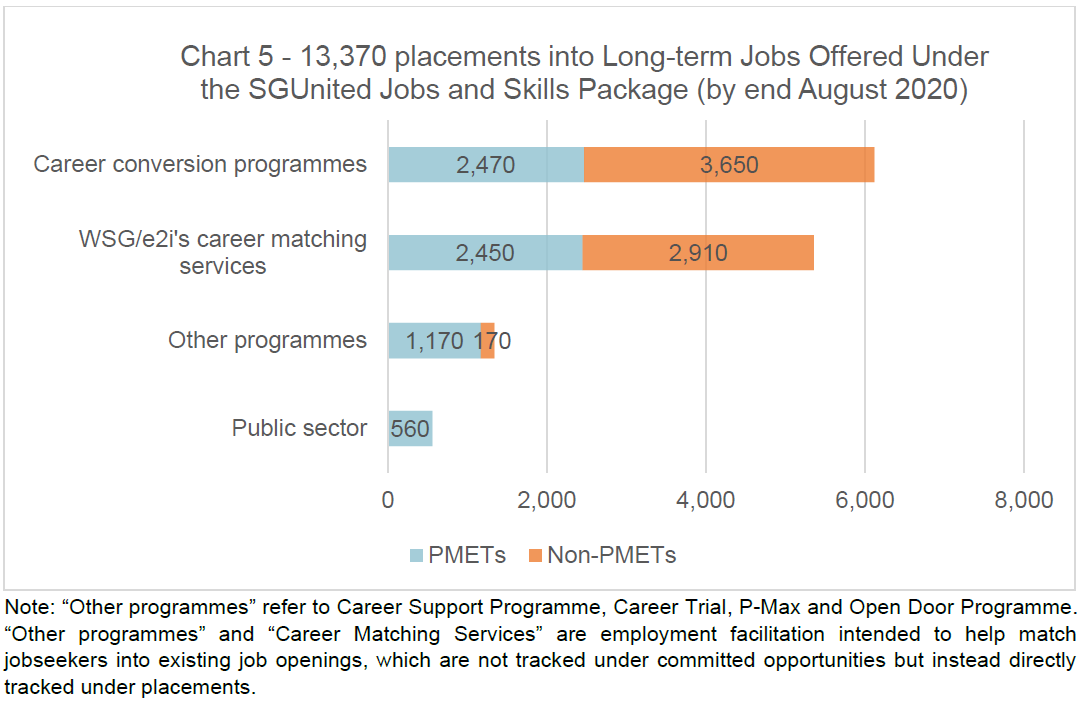
Top sectors with the most matches into opportunities
- As at end-August, the top five sectors in which most jobseekers and workers were placed into opportunities were similar to that observed at the end of July – i.e. Information & Communications (2,650), Food Services (1,680), Professional Services (1,420), Healthcare (1,180) and Finance & Insurance (1,160) (breakdown in Chart 6).
a. Of note, the Food Services sector placed the highest number of jobseekers into long-term jobs such as Restaurant Managers, Business Development Managers and Bakers.
b. The Healthcare sector placed the highest number of jobseekers into short-term jobs (750). Within this sector, some jobseekers have also taken on long-term jobs such as nursing professionals and dental assistants.
c. The Information & Communications sector placed the highest number of jobseekers into all other types of opportunities. These include:
- Company-hosted opportunities such as Shopee GoSchool Programme which supports mid-career jobseekers in acquiring industry-relevant skills and new job opportunities (e.g. Software Engineer; GoLang Developer) to take-up positions in Software and System Engineer, Junior Cybersecurity Consultant, Business Analyst Trainee, Cloud and Systems Trainee.
- Training courses in Digital Marketing, E-commerce and UX/UI Design.
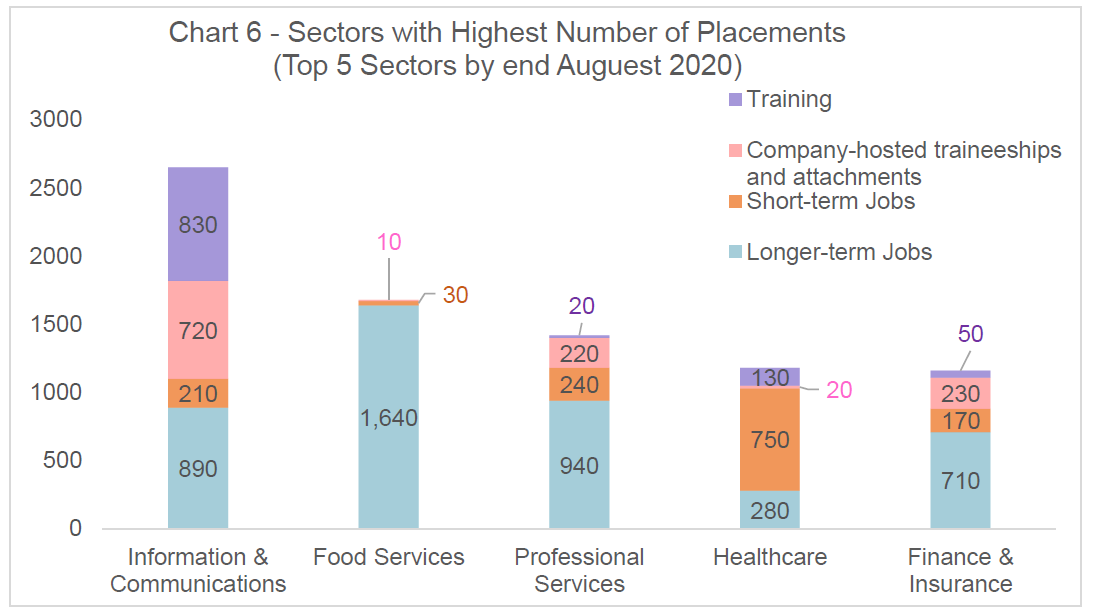
- With increased efforts to promote and encourage jobseekers to take on company-hosted traineeships and attachments as well as training opportunities, placements into these opportunities have increased by three-folds since end-July (from 1,170 as at end-July to 3,510 as at end-August). Some possible reasons are:
a. After the SGUnited Mid-career Pathways Programme was launched in Aug 2020, companies offering traineeships and attachments now have a wider pool of talent to select from (fresh graduates and mid-career individuals).
b. Lower barriers of entry when jobseekers tap on these opportunities to enter sectors, they previously lacked experience in.
c. Jobseekers are increasingly keen to pick up useful skills that are relevant to better position themselves for the eventual economic recovery. This is evident in the training courses most highly sought after by individuals, with courses relating to digital marketing & e-commerce, ICT, cloud engineering, healthcare, business management, seeing the highest number of enrolments.
Update to Unemployment Rate
- We have started to track unemployment rate on monthly basis to monitor the labour situation more closely. We observe that while monthly unemployment rates have so far generally remained lower than past recessionary highs , it has been gradually rising. Resident unemployment rate rose by 0.4-percentage-point in the month of August, slightly higher than the 0.3-percentage-point increase in the month of July. It remains to be seen if unemployment will rise more quickly in the coming months (refer to Chart 7).
- Nonetheless, the Monetary Authority of Singapore estimates that the combined Budgets will prevent Singapore’s economy from contracting by a further 5.6% of GDP in 2020, and 4.8% in 2021. Our economic support measures will also offset some of the rise in resident unemployment rate by about 1.7% this year. This could mean about 155,000 jobs saved over these two years, although we will still see jobs losses overall.
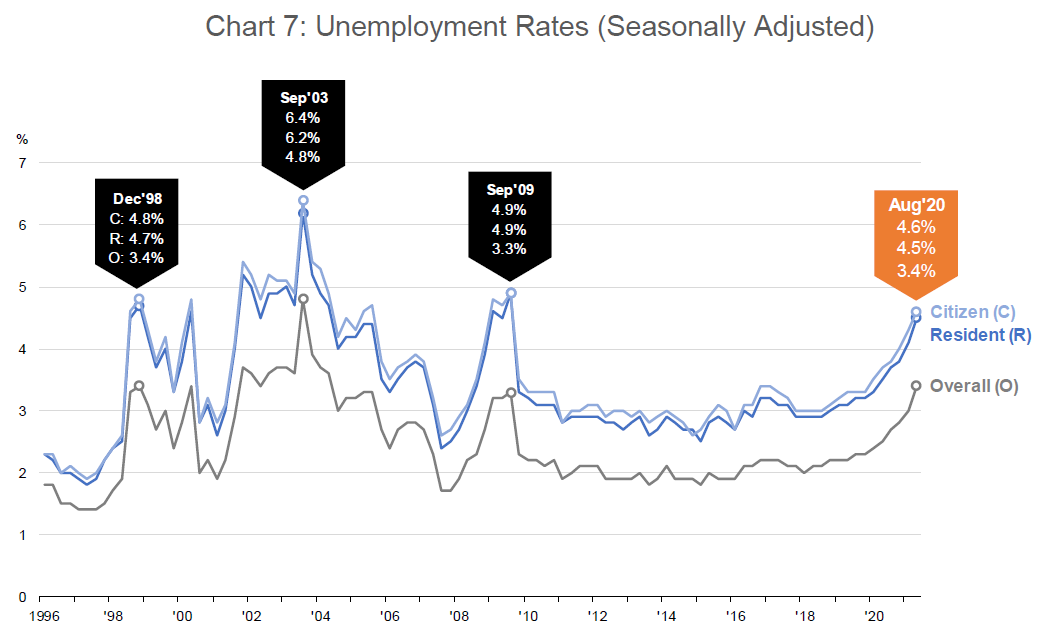
National Jobs Council’s immediate focus: matching jobseekers to opportunities
- Although the National Jobs Council has exceeded the original target of bringing together 100,000 jobs and skills opportunities, there remains a significant number of unfilled vacancies. According to ground feedback, there continues to be mismatches in expectations and skills. To increase the number of successful matches requires the strong support and cooperation from employers and jobseekers:
a. Employers should look beyond candidates with backgrounds that are an exact match to the job. Instead, employers are more likely to be successful if they focus on candidates’ transferrable skills and tap government funding support to bride skills gaps.
- Because of the slack in the job market, there are mid-career entrants with well-honed soft skills and working experience that can be valuable to companies.
- We have also launched the Jobs Growth Incentive (JGI) scheme which provides substantial salary support to enable employers to bring forward their hiring plans and grow their local workforce from Sep 2020 till Feb 2021.
b. Jobseekers may also be placed more quickly if they are prepared to consider less familiar roles or sectors. These include individuals who:
- Are prepared to make a mid-career switch to take advantage of opportunities in growth areas; and
- Have embarked on alternative pathways such as short-term contract work, traineeships or attachments to learn new skills, gain new experience and establish new networks.
c.
c. Jobseekers may wish to seek professional career guidance early, which can help equip them with techniques to make their job search more efficient and effective. Jobseekers can also tap on a range of online and physical resources under Career Matching Services to increase their chances of securing a job. These include:
- The islandwide network of 5 WSG Careers Connect and NTUC’s e2i Centres, 24 SGUnited Jobs and Skills Centres, and the Careers Connect On-the-Go; and
- The MyCareersFuture portal to enable more efficient and effective search based on jobs that best suit their skill sets.
- There have been successful matches between jobseekers and employers who remained open in their respective searches:
a. WEDA StudioInc Pte Ltd was looking for a HR and Admin Manager to support their operations, when they found Intan Adam’s profile on MyCareersFuture through the portal’s “Suggested Talent” feature.
- 47-year-old Intan Adam had taken a year off to travel after working in the manufacturing industry for over 20 years. However, she had difficulty finding a job when she tried to re-enter the workforce in Oct 2018.
- After more than six months of fruitless search, she reached out to WSG in August 2019 and was referred to one of WSG’s Career Matching Providers, Ingeus, whose career coach guided her in her job search, including improving her resume and online profile.
b. When WEDA found her profile and resume on MyCareersFuture in Apr 2020, they were attracted by her years of experience and her abilities in leadership, interpersonal relationship building and critical thinking, and reached out to her though she lacked industry knowledge in built environment.
- Though Intan did not apply for the job, she stayed open and leaped at the opportunity, even if it meant switching sectors.
c.Today, Intan closely supports WEDA’s operations, including the setting up of a new division, Greyline Solutions.
- WEDA also tapped on the P-Max programme to help her transit and assimilate into the SME working environments.
d.Intan has also helped the company come onboard the SGUnited Traineeships Programme. For example, WEDA was able to enrol three fresh graduates as SGUnited trainees:
- Koh Jie Lyn, a graduate with a degree in Digital Animation, was attracted to the opportunity to make creative decisions and actively participate in building the brand identity for the company’s new division, Greyline Solutions.
- Mao Yue, who has a degree in Architectural Studies, found her interests aligned with the container dormitory project which Greyline Solution was doing.
- Pung Li Kuang, who also has a degree in Architectural Studies,was drawn to the purpose of WEDA’s Greyline Solutions to address issues of dormitory living. This was aligned with his own aspiration to design on the basis of good cause.
More information
- To find out more about:
- Opportunities available under the SGUnited Jobs and Skills Package, please visit the MyCareersFuture portal.
- WSG’s programmes and career advisory and matching services, please visit www.mycareersfuture.gov.sg/careercoaching (QR code below) or call WSG’s hotline at 6883 5885.
- SSG’s SGUnited Skills programmes, jobseekers can visit https://www.myskillsfuture.sg/sgunitedskills.
- Upcoming engagement and outreach events organised by NTUC’s e2i and WSG, jobseekers can visit https://www.ssg-wsg.gov.sg/events.html or https://e2i.com.sg/events/. The list of events and activities for Oct 2020 can also be found in Annex C.